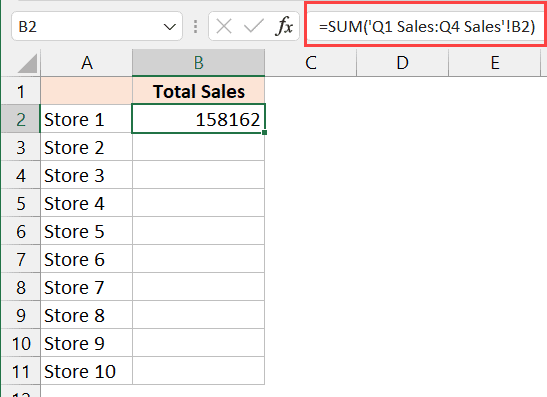7 Ways to Calculate Values Across Excel Sheets

Excel is an incredibly powerful tool for data analysis and management, allowing users to perform complex calculations across multiple sheets within the same workbook. This capability is essential for anyone dealing with large datasets, financial models, or simply organizing personal or business finances. Here's an in-depth exploration of seven methods to calculate values across Excel sheets, ensuring you can manipulate data efficiently and effectively.
1. Using 3D References

3D references in Excel allow you to perform calculations that span multiple worksheets within a workbook. This technique is particularly useful when you have the same data layout across different sheets, like monthly financial summaries.
- To create a 3D reference, start your formula in a cell.
- Use the SUM function with references to the sheets in this format:
=SUM(Sheet1:Sheet3!A1), where Sheet1 to Sheet3 are the sheets you wish to calculate across. - The formula will sum the value in cell A1 from Sheet1 through Sheet3.
🔎 Note: Ensure all sheet names are spelled correctly and exist in the workbook to avoid errors.
2. SUMIF and SUMIFS Functions

For more targeted calculations, use SUMIF and SUMIFS functions to aggregate data based on certain criteria:
- SUMIF: Add up values in a range that meet a single criterion. The syntax is:
=SUMIF(range, criteria, [sum_range]). - SUMIFS: Works similarly but allows multiple criteria. Syntax:
=SUMIFS(sum_range, criteria_range1, criteria1, [criteria_range2, criteria2], ...).
To calculate across sheets:
- Reference each sheet individually in the sum range or criteria range. For example:
=SUMIF(Sheet1!A:A, ">20", Sheet1!B:B) + SUMIF(Sheet2!A:A, ">20", Sheet2!B:B)
3. VLOOKUP Across Multiple Sheets

VLOOKUP can help you retrieve data from different sheets based on a common key. Here’s how:
- Use the CHOOSE function within VLOOKUP to select from multiple sheets. Example:
=VLOOKUP(A1, CHOOSE({1,2}, Sheet1!A:B, Sheet2!A:B), 2, FALSE) - This formula searches for A1 in both Sheet1 and Sheet2, returning the value from column B of the sheet where A1 is found.
4. IF and IFS Functions

For conditional calculations, IF and IFS functions can be used across sheets:
- IF function:
=IF(condition, [value_if_true], [value_if_false]) - IFS function (in newer Excel versions):
=IFS(logical_test1, value_if_true1, [logical_test2, value_if_true2], …)
To apply these across sheets, combine with indirect referencing:
=IF(Sheet1!A1 > 100, Sheet2!B1, Sheet3!C1)
5. Using Indirect Function

The INDIRECT function can dynamically reference different sheets:
- Use a cell to store the sheet name: e.g.,
=INDIRECT(“‘” & A1 & “’!B2”), where A1 contains the sheet name. - This allows for changing sheet references without altering the formula.
6. INDEX and MATCH Across Sheets

The combination of INDEX and MATCH provides a robust lookup solution across sheets:
- Example:
=INDEX(Sheet2!B:B, MATCH(A2, Sheet2!A:A, 0))looks up A2 in Sheet2’s column A and returns the corresponding value in column B.
Using CHOOSE with INDEX and MATCH can further enhance the functionality, allowing you to look up across multiple sheets.
7. Named Ranges Across Workbooks

Create named ranges to simplify formulas across workbooks:
- Define names in each sheet or workbook.
- Reference these names in your formulas:
=SUM(Sheet1!AnnualSales, Sheet2!AnnualSales), where AnnualSales is a named range defined in each sheet.
In this detailed guide, we've explored seven powerful techniques to calculate values across Excel sheets. These methods empower you to manage and analyze your data with greater efficiency, enabling you to draw insights from your data across multiple worksheets. Whether you're working with financial models, sales data, or inventory management, mastering these techniques can significantly enhance your productivity and data analysis capabilities in Excel.
By understanding and applying these methods, you're not only streamlining your workflow but also harnessing the full potential of Excel as an analytical tool. With practice, these operations become second nature, allowing you to manipulate complex data structures with ease.
Can I use these methods across different workbooks?

+
Yes, you can extend these methods to reference cells from different workbooks by including the workbook name in the reference, e.g., ’[Workbook.xlsx]Sheet1’!A1.
How do I handle errors when using INDIRECT?

+
Use error handling functions like IFERROR to manage errors when referencing sheets dynamically with INDIRECT, e.g., =IFERROR(INDIRECT(“‘” & A1 & “’!B2”), “Sheet not found”).
What are the limitations of using 3D references?

+
3D references are limited to the sheets within a single workbook, and their performance might degrade with large datasets or numerous sheets.



